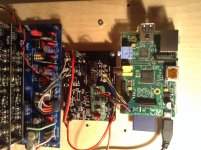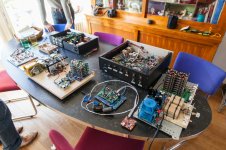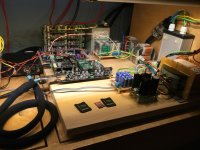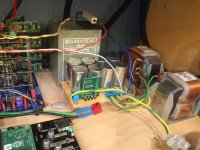Old vs new dddac is two different animals. The latest dddac with Ian’s reclocker is very,good.
Old vs new dddac is two different animals. The latest dddac with Ian’s reclocker is very,good.
Yep, someone who has both wrote to me some time ago it is like the dddac1543 is like a tough boxer and the dddac1794 more like a beautiful ballerina 😀
Kind of good metaphor - the 1543 is also very good, but very direct, sometimes brutal - The 1794 most of you know already, say no more: 😎
Putting both in the ring? Vice versa on stage in the theater? Prespective and expectations for outcome - just think about this...
They both have their strengths! It might be personal as well - so yes go ahead and compare!
They both have their strengths! It might be personal as well - so yes go ahead and compare!
Should we mention the DSD.DDDAC ? (makes a lot of D !) 😀😉
Should we mention the DSD.DDDAC ? (makes a lot of D !) 😀😉
That will come next year 🙄 Prototype was extremely promising, but hey, time....
expectation management: as it is not based on PCM conversion like so many others, it will be a stand alone unit for pure DSD conversion into an anlog signal. without crazy FIR filtering (some is needed however) and with super analog signal path - be patient 😱 !
That will come next year 🙄 Prototype was extremely promising, but hey, time....
expectation management: as it is not based on PCM conversion like so many others, it will be a stand alone unit for pure DSD conversion into an anlog signal. without crazy FIR filtering (some is needed however) and with super analog signal path - be patient 😱 !
I am super interested in this! But... that will work with DSD sources only, right? And how many DSD albums do you guys have?
I am super interested in this! But... that will work with DSD sources only, right? And how many DSD albums do you guys have?
Zero.....there is always ROON 😀
Really good stuff going on here! I just ordered the Tent shunts.
I feel the next big step would be to increase the number of DAC boards to more than what is currently possible (I believe 8 boards currently). Any chances this is going to happen? 16 boards or more?
I would like to use 16 Tent boards too, but it may need a motherboard with extra buffering with the additional regulators to supply the buffers as well.
A bigger motherboard may be needed 🙂
I would like to use 16 Tent boards too, but it may need a motherboard with extra buffering with the additional regulators to supply the buffers as well.
A bigger motherboard may be needed 🙂
Have you figured out how much power (watts) you will need to power 16 boards. At some point the additional complexity, power and spacing requirements are going to work against any sound quality improvement.
Hi Doede,
That is a nice comparison of the regulators!
Maybe you have missed it in all the dddac power at the time (second picture) but you have already heard the dac with the tent shunt on the motherboard during our listening session (First picture) 😉
Might I also suggest another modification? I have used a mosfet bridge instead of diodes, this makes the highs a tad more clean and open.
They do not have the switching characteristic of a diode so no rf noise is generated.
You can see my power supply in the last picture.
Regards,
That is a nice comparison of the regulators!
Maybe you have missed it in all the dddac power at the time (second picture) but you have already heard the dac with the tent shunt on the motherboard during our listening session (First picture) 😉
Might I also suggest another modification? I have used a mosfet bridge instead of diodes, this makes the highs a tad more clean and open.
They do not have the switching characteristic of a diode so no rf noise is generated.
You can see my power supply in the last picture.
Regards,
Attachments
Last edited:
Have you figured out how much power (watts) you will need to power 16 boards. At some point the additional complexity, power and spacing requirements are going to work against any sound quality improvement.
I have a nice power supply based on the original power supply, but I am using a TIP142 transistor which can supply over 4A at 12V with no problem
Hi Doede,
That is a nice comparison of the regulators!
Maybe you have missed it in all the dddac power at the time (second picture) but you have already heard the dac with the tent shunt on the motherboard during our listening session (First picture) 😉
Might I also suggest another modification? I have used a mosfet bridge instead of diodes, this makes the highs a tad more clean and open.
They do not have the switching characteristic of a diode so no rf noise is generated.
You can see my power supply in the last picture.
Regards,
Hi Stefan,
how time flies..... yes remember now, that was 5 years ago and a very nice audio day 🙂
well, seems it took me 5 years to conclude this was (for me now) still the best, LOL
I saw these rectifier bridges and was intrigued by it, nice you can confirm this. do you have link where you bought them?
I have a nice power supply based on the original power supply, but I am using a TIP142 transistor which can supply over 4A at 12V with no problem
may be add to this Alex, you always had 15 boards working and was very happy with it - but 16 seemed to be the limit somehow... and we never figured out why...
It was strange, we tried extra buffering, larger series resistors and even terminating resistors on the top stack ...may be add to this Alex, you always had 15 boards working and was very happy with it - but 16 seemed to be the limit somehow... and we never figured out why...
So 15 boards are okay, at least in one case... with the red or blue mainboard?
It was with the blue mainboard and using the pre tent boards.
Doede,
I think that you can apply this GB for the Mosfet bridge Ideal Bridge second GB
There may be other sources for commercial products, and you can have gerber files from Kevin Gilmore aswell.
I think that you can apply this GB for the Mosfet bridge Ideal Bridge second GB
There may be other sources for commercial products, and you can have gerber files from Kevin Gilmore aswell.
Doede,
I think that you can apply this GB for the Mosfet bridge Ideal Bridge second GB
There may be other sources for commercial products, and you can have gerber files from Kevin Gilmore aswell.
Uuuuuoohh, tempting! Which version did you use in your DDDAC? Standard or low current?
I have not.
I'm applying to the GB, for the standard version.
My DDDAC is in "bad shape" now, everything disconnected and waiting for a Sowter TVC solution on the one hand, and Andrea's new clock on the other hand (don't like the Crystek on my Cronus).
I'm applying to the GB, for the standard version.
My DDDAC is in "bad shape" now, everything disconnected and waiting for a Sowter TVC solution on the one hand, and Andrea's new clock on the other hand (don't like the Crystek on my Cronus).
Last edited:
Hi Stefan,
how time flies..... yes remember now, that was 5 years ago and a very nice audio day 🙂
well, seems it took me 5 years to conclude this was (for me now) still the best, LOL
I saw these rectifier bridges and was intrigued by it, nice you can confirm this. do you have link where you bought them?
Hi Doede,
Is it already 5 years? And my dddac is still running unchanged; at least the motherboard with dacs, the streamer and power supply are changed for the better. There was much to gain on the streamer and clock part but the dac is pretty much maxed out.
After some experimenting with another dac and comparisons to some expensive commercial dacs this one still is the best sounding.
I use the mosfet bridge from the link of G600. I use the standard version but the low current will also do.
The prototype dsd dac is also in the picture, it would be nice if you could release this design for us diy-ers 😉
Last edited:
- Home
- Source & Line
- Digital Line Level
- A NOS 192/24 DAC with the PCM1794 (and WaveIO USB input)



